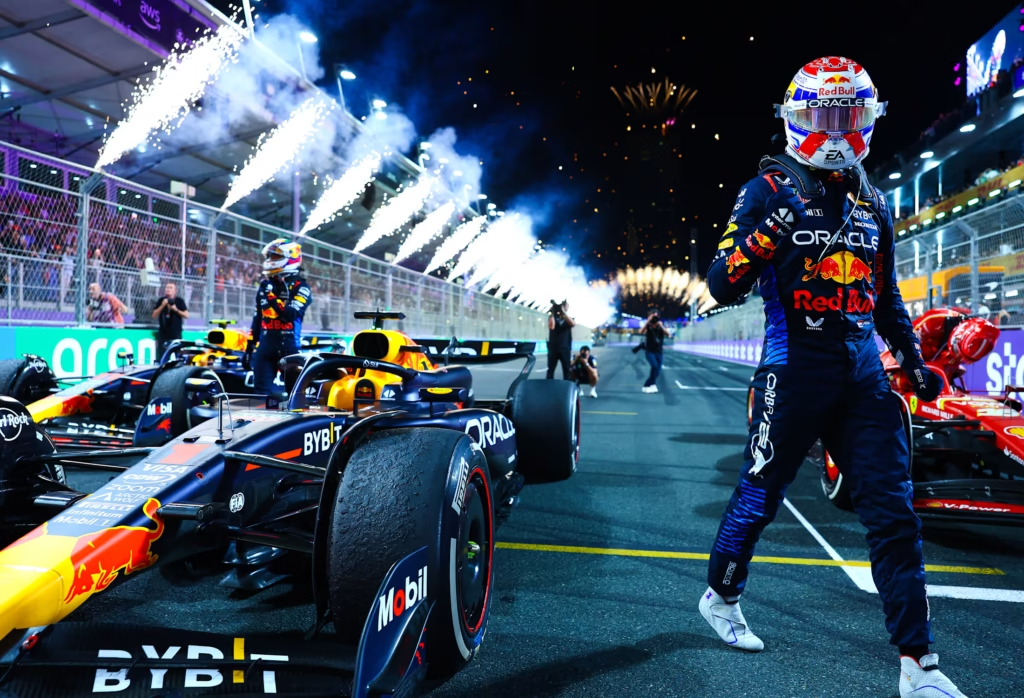
In recent times, the epitome of motorsports, Formula 1 or commonly known as the F1, has gained extreme popularity. Globally, the fan following of the motorsport has grown exponentially. The credit can be given to multiple marketing strategies of Formula 1, such as “Drive to Survive” on Netflix, social media contents, live broadcasting by various online platforms like F1TV and Fan Code, merchandise, etc. Although at a glance, Formula 1 might seem like a simple motorsport, where the drivers drive around a circuit for multiple laps, it is much more complicated, with a lot of logistics and technologies fueling it from the behind. Therefore, if you are someone trying to start following the sport but is being overwhelmed by the terminologies and never-ending information, I am here to give you a quick overview of the basic topics related to Formula 1.
Topics covered in the article:
- Common terminologies
- Teams & Drivers
- Race Weekend
- Races & Circuits
- Pitlane & Pitstop
- Race Cars
- Tyres
- DRS
- Battery
- Flags
Common Terminologies:
| TERMINOLOGY | MEANING |
| F1 | Formula 1 |
| FIA | Fédération Internationale de l’Automobile |
| GP | Grand Prix |
| WDC | World Drivers’ Championship |
| WCC | World Constructors’ Championship |
| Season | 1 year that comprise all the championship-related races |
| FP | Free Practice |
| P | Position |
| Q | Qualifying |
| DRS | Drag Reduction System |
| DNF | Did Not Finish |
| Quali | Qualifying race |
| Lights out | 5 red lights going off to start a race |
| Box | Enter the pit |
| Grid | The lineup of the drivers on the track |
| Race control | Operations team responsible for monitoring the races and enforcing rules |
| Stewards | Officials who monitor the races and enforce rules |
| Marshals | Trackside personnels responsible for ensuring drivers’ and spectators’ safety |
| Race Director | Official responsible for overseeing all F1-related aspects |
Teams & Drivers:
Although the teams, also known as constructors, and the drivers can change over the time, currently, there are 10 teams, each with 2 drivers, i.e., a total of 20 drivers at present. While a change in constructors is not frequent and may remain the same for several years, on the other hand, the drivers may change within a season due to various reasons. The current lineup of Formula 1 as of today, including the expected changes in 2026 is as follows:
| SL. NO. | TEAM | DRIVERS |
| 1 | McLaren | Oscar Piastri & Lando Norris |
| 2 | Ferrari | Charles Leclerc & Lewis Hamilton |
| 3 | Mercedes | George Russell & Kimi Antonelli |
| 4 | Red Bull Racing | Max Verstappen & Yuki Tsunoda |
| 5 | Williams | Alexander Albon & Carlos Sainz |
| 6 | Aston Martin | Fernando Alonso & Lance Stroll |
| 7 | Racing Bulls (an independent sister team of Red Bull Racing) | Liam Lawson & Isack Hadjar |
| 8 | Kick Sauber (will become Audi in 2026) | Nico Hulkenberg & Gabriel Bortoleto |
| 9 | Haas | Esteban Ocon & Oliver Bearman |
| 10 | Alpine | Pierre Gasly & Franco Colapinto |
| 11 | Cadillac (will join F1 from 2026) | Sergio Perez (former Red Bull Racing driver) & Valtteri Bottas (currently Mercedes’ reserve driver) |
Race Weekend:
Formula 1 races are held on weekends, i.e., Saturdays and Sundays. There are three stages per race weekend:
- Free Practice: 3 free practice rounds, FP1, FP2, and FP2 are allowed for every race, where each team test their cars before the race.
- Qualifying: After the free practice rounds, during the qualifying rounds, drivers set lap times. Based on their lap times, they are allotted grid position in the final race. The qualifying is carried out in 3 rounds, Q1, Q2, and Q3. In Q1, the slowest 5 drivers are knocked out, in Q2, the next 5 slowest drivers are knocked out, and in Q3, the drivers secure grid positions on the track based on their lap times.
- Race: On the final race, drivers start the race from the position based on their qualifying lap time. For example, the fastest driver gets to start the race ahead of everyone, known as the pole position, and the slowest one starts from the last. There might be special circumstances, such as a penalty, where a driver might have to start the race from the pitlane.
Races & Circuits:
Races:
Each season, there are two types of F1 championships, known as the Constructors’ Championship and the Drivers’ Championship.
Currently, each season, 24 Grand Prix (GP) races, along with 6 additional shorter Sprint races are held at multiple circuits across multiple countries. Every GP race, the top 10 drivers, and the top 8 drivers for every Sprint race, are awarded with points. GP races and the Sprint races are held during the same weekends, with Sprint races generally being held before the GP races. Therefore, by the end of a season, the driver to collect most points, wins the World Drivers’ Championship, and since every team has 2 drivers, the team having the highest cumulative points wins the World Constructors’ Championship.
The details of the races and points are as follows:
1. Grand Prix races:
| Distance per race | Minimum 305 kilometres |
| Number of races each season | 24 |
Grand Prix race points:
| POSITION | POINTS |
| 1 | 25 |
| 2 | 18 |
| 3 | 15 |
| 4 | 12 |
| 5 | 10 |
| 6 | 8 |
| 7 | 6 |
| 8 | 4 |
| 9 | 2 |
| 10 | 1 |
2. Sprint races:
| Distance per race | Around 100 kilometers |
| Number of races each season | 6 (one fourth of number of GP races) |
Sprint race points:
| POSITION | POINTS |
| 1 | 8 |
| 2 | 7 |
| 3 | 6 |
| 4 | 5 |
| 5 | 4 |
| 6 | 3 |
| 7 | 2 |
| 8 | 1 |
Circuits:
While the circuits may change over the time, the current circuits and their respective countries are as follows:
| SL. NO. | COUNTRY | RACE NAME | CIRCUIT NAME |
| 1 | Australia | Australian Grand Prix | Melbourne Grand Prix Circuit |
| 2 | China | Chinese Grand Prix | Shanghai International Circuit |
| 3 | Japan | Japanese Grand Prix | Suzuka International Racing Course |
| 4 | Bahrain | Bahrain Grand Prix | Bahrain International Circuit |
| 5 | Saudi Arabia | Saudi Arabian Grand Prix | Jeddah Street Circuit |
| 6 | United States | Miami Grand Prix | Miami International Autodrome |
| 7 | Italy | Grand Premio dell’Emilia-Romagna (also known as Imola Grand Prix) | Autodromo Enzo e Dino Ferrari |
| 8 | Monaco | Grand Prix De Monaco | Circuit de Monaco |
| 9 | Spain | Grand Prix De Espana | Circuit de Barcelona-Catalunya |
| 10 | Canada | Grand Prix Du Canada | Circuit Gilles-Villeneuve |
| 11 | Austria | Austrian Grand Prix | Red Bull Ring |
| 12 | Great Britain | British Grand Prix | Silverstone Circuit |
| 13 | Belgium | Belgian Grand Prix | Circuit de Spa-Francorchamps |
| 14 | Hungary | Hungarian Grand Prix | Hungaroring |
| 15 | Netherlands | Dutch Grand Prix | Circuit Park Zandvoort |
| 16 | Italy | Grand Premio D’Italia | Autodromo Nazionale Monza |
| 17 | Azerbaijan | Azerbaijan Grand Prix | Baku City Circuit |
| 18 | Singapore | Singapore Grand Prix | Marina Bay Street Circuit |
| 19 | United States | United States Grand Prix | Circuit of the Americas |
| 20 | Mexico | Grand Premio de Mexico | Autodromo Hermanos Rodriguez |
| 21 | Brazil | Grand Premio de Sao Paulo | Autodromo Jose Carlos Pace |
| 22 | United States | Vegas Grand Prix | Las Vegas Street Circuit |
| 23 | Qatar | Qatar Grand Prix | Losail International Circuit |
| 24 | Abu Dhabi | Abu Dhabi Grand Prix | Yas Marina Circuit |
Additionally, pre-season testing, where the teams test their cars before the start of a season, is done in Sakhir.
Pitlane & Pitstop:
- Pit: The garage where the race cars are stored and repaired.
- Pitlane: The lane that connects the garages to the main racetrack. Speed limits are set for driving in the pitlane, and violation of the limit can result in penalty.
- Pitstop: The stops taken by the drivers at their respective team pits to change tyres or get other quick fixes, if required, during a race. Most pit stops are around 2 to 3 seconds.
- Pit crew: A team of mechanics responsible for carrying out changes or fixes in the race car.
Race Cars:
Although every team designs their own cars with variations in designs and aerodynamics, every car must have the same standard specifications, such as weight, size, power, fuel, etc. set by the FIA. Also, the number of components, such as engine, tyres, transmission, etc. allotted to each team every year is limited. Additionally, changing components or not adhering to the FIA regulation may result in penalties, such as drop in grid position, time penalty, financial penalty, race ban, etc.
Tyres:
Currently, the tyres used on F1 cars are 18-inch tyres by Pirelli. There is a range of tyres that the teams can opt for based on various weather and track conditions, as well as team strategies. However, the number of tyres allotted to each team is limited.
There are 5 major types of tyres:
- Soft/Slick: Slicks provide most grip and speed on a dry track but do not last long. They are marked red.
- Medium: Medium tyres have a balance between grip and longevity. They are marked yellow.
- Hard: Hard tyres last long but provide less amount of grip and speed. They are marked white.
- Intermediate: These are preferable during light rain or moderately wet tracks. They are marked green.
- Rain: As the name suggests, these tyres are made for heavy rain conditions. They provide maximum grip in the rain but provide least speed on a dry track. Rain tyres are marked blue:
DRS:
DRS stands for Drag Reduction System. It is a special feature, that can be controlled with a button on the steering wheel, that allows the rear wing of the F1 cars to open and reduce drag or downforce. This increases the speed of the cars, which is extremely useful for overtaking in straight lines. Reportedly, DRS can give a boost of extra speed up to 12 km/h. However, DRS can only be activated within allotted DRS zones within a racetrack and when the car is within a 1 second distance from the car ahead of it. Additionally, since DRS reduced downforce, use of DRS is deactivated by the race control during a rainy weather condition to avoid crashes.
Battery:
Another term that you will often hear about while watching an F1 race is “battery.” The current generation F1 cars are hybrid, which means that they have an internal combustion engine (ICE) as well as an electric motor. While the ICE is powered by racing fuels, the motor is powered by a battery. The electric motor’s power is used to gain extra boost during acceleration and quick overtakes. While activating the electric motor discharges the battery, through a special energy recovery system, that utilises the car’s kinetic energy under braking and exhaust gases, the battery is recharged during a race. Therefore, the drivers use and recharge the battery, strategically, during the races.
Flags:
Like every other motorsport, F1 also has multiple flags for various situations. The flags and their meanings are as follows:
| SL. NO. | COLOUR | MEANING |
| 1 | Green | Clear track. |
| 2 | Yellow (single) | Hazard on the track. Reduce car speed. No overtaking. |
| 3 | Yellow (double) | Hazard on the track. Reduce car speed. No overtaking. Track blocked/marshal at work. |
| 4 | Yellow with red stripes | Low grip level on the track. Probable oil or water on track. |
| 5 | Red | Stop race. |
| 6 | White | Slow driver ahead. |
| 7 | Blue | Traffic approaching from behind. The car is about to be lapped; let the car behind pass. |
| 8 | Code 60 | 60 km/h speed limit. |
| 9 | Black | Driver disqualified. |
| 10 | Black with orange disc | Car has mechanical problem and must enter the pit. |
| 11 | Black and white (diagonal) | Warning for a driver for exhibiting non-sportsman-like behaviour. |
| 12 | Black and white chequered | End of race. |
Conclusion:
Although I have tried to cover as many basics as possible, this is just the surface and there is still a lot to cover. I will either update more topics in this article as the time goes by or add additional articles, covering more technical sides of Formula 1.
I hope the topics covered in this article will provide you some help to start following Formula 1.
Last but not least, please let me know if you would like me to cover any other specific Formula 1 or motorsport-related topics.
Sources: www.formula1.com and www.espn.in

